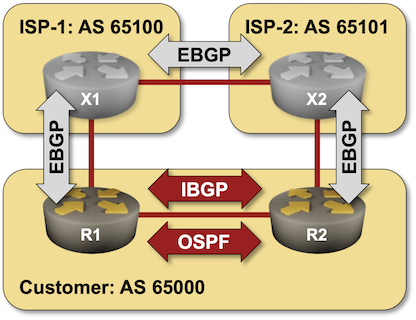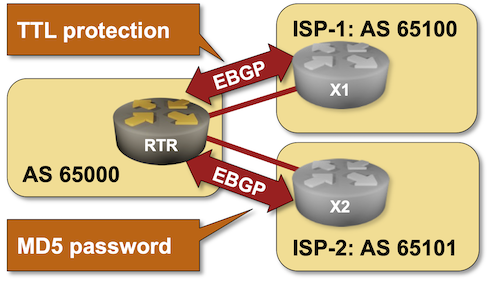Category: BGP
Worth Reading: Taming the BGP Reconfiguration Transients
Almost exactly a decade ago I wrote about a paper describing how IBGP migrations can cause forwarding loops and how one could reorder BGP reconfiguration steps to avoid them.
One of the paper’s authors was Laurent Vanbever who moved to ETH Zurich in the meantime where his group keeps producing great work, including the Chameleon tool (code on GitHub) that can tame transient loops while reconfiguring BGP. Definitely something worth looking at if you’re running a large BGP network.
Worth Exploring: BGP from Theory to Practice
My good friend Tiziano Tofoni finally created an English version of his evergreen classic BGP from theory to practice with co-authors Antonio Prado and Flavio Luciani.
I had the Italian version of the book since the days I was running SDN workshops with Tiziano in Rome, and it’s really nice to see they finally decided to address a wider market.
Also, you know what would go well with that book? Free open-source BGP configuration labs of course 😉
BGP Labs: Multivendor External Routers
Here’s a quick update on the BGP Labs project status: now that netlab release 1.6.4 is out, I could remove the dependency on using Cumulus Linux as the external BGP router.
You can use any device that is supported by bgp.session and bgp.policy plugins as the external BGP router. You could use Arista EOS, Aruba AOS-CX, Cisco IOSv, Cisco IOS-XE, Cumulus Linux or FRR as external BGP routers with netlab release 1.6.4, and I’m positive Jeroen van Bemmel will add Nokia SR Linux to that list.
If you’re not ready for a netlab upgrade, you can keep using Cumulus Linux as external BGP routers (I’ll explain the behind-the-scenes magic in another blog post, I’m at the Deep Conference this week).
For more details, read the updated BGP Labs Software Installation and Lab Setup guide.
Video: History of BGP Route Leaks
I’ll be talking about Internet routing security at the Deep conference in a few days, and just in case you won’t be able to make it1 ;) here’s the first bit of my talk: a very brief history of BGP route leaks2.
Note: you’ll find more Network Security Fallacies videos in the How Networks Really Work webinar.
BGP Labs: Build Larger Networks with IBGP
After going through the BGP basics, it’s time to build a network that has more than one BGP router in it, starting with the simplest possible topology: a site with two WAN edge routers.

… updated on Thursday, November 2, 2023 10:36 UTC
Will Network Devices Reject BGP Sessions from Unknown Sources?
TL&DR: Violating the Betteridge’s Law of Headlines, the answer is “Yes, but the devil is in the details.”
It all started with the following observation by Minh Ha left as a comment to my previous BGP session security blog post:
I’d think it’d be obvious for BGP routers to only accept incoming sessions from configured BGP neighbors, right? Because BGP is the most critical infrastructure, the backbone of the Internet, why would you want your router to accept incoming session from anyone but KNOWN sources?
Following my “opinions are good, facts are better” mantra, I decided to run a few tests before opinionating1.
BGP Labs: TCP-AO Protection of BGP Sessions
A few days after I published the EBGP session protection lab, Jeroen van Bemmel submitted a pull request that added TCP-AO support to netlab. Now that the release 1.6.3 is out, I could use it to build the Protect BGP Sessions with TCP Authentication Option (TCP-AO) lab exercise.
BGP Labs: Route Aggregation
In the BGP Route Aggregation lab you can practice:
- OSPF-to-BGP route redistribution
- BGP route aggregation
- Suppression of more-specific prefixes in the BGP table
- Prefix-based filtering of outbound BGP updates

BGP Session Security: Be Very Skeptical
A while ago I explained how Generalized TTL Security Mechanism could be used to prevent denial-of-service attacks on routers running EBGP. Considering the results published in Analyzing the Security of BGP Message Parsing presentation from DEFCON 31 I started wondering how well GTSM implementations work.
TL&DR summary:
BGP Labs: Use BFD to Speed Up Convergence
In the next BGP labs exercise, you can practice tweaking BGP timers and using BFD to speed up BGP convergence.

BGP Labs: Protect EBGP Sessions
I published another BGP labs exercise a few days ago. You can use it to practice EBGP session protection, including Generalized TTL Security Mechanism (GTSM) and TCP MD5 checksums1.

-
I would love to add TCP-AO to the mix, but it’s not yet supported by the Linux kernel, and so cannot be used in Cumulus Linux or FRR containers. ↩︎
BGP Labs: Bidirectional Route Redistribution
In the next BGP labs exercise, you’ll build the customer part of an MPLS/VPN solution. You’ll use bidirectional OSPF-to-BGP route redistribution to connect two sites running OSPF over a Service Provider MPLS backbone.

Case Study: BGP Routing Policy
Talking about BGP routing policy mechanisms is nice, but it’s even better to see how real Internet Service Providers use those tools to implement real-life BGP routing policy.
Getting that information is incredibly hard as everyone considers their setup a secret sauce. Fortunately, there are a few exceptions; Pim van Pelt described the BGP Routing Policy of IPng Networks in great details. The article is even more interesting as he’s using Bird2 configuration language that looks almost like a programming language (as compared to the ancient route-maps used by vendors focused on “industry-standard” CLI).
Have fun!
BGP Labs: Simple Routing Policy Tools
The first set of BGP labs covered the basics; the next four will help you master simple routing policy tools (BGP weights, AS-path filters, prefix filters) using real-life examples:
- Use BGP weights to prefer one of the upstream providers
- Prevent route leaking between upstream providers with an AS-path filter
- Filter prefixes advertised by your autonomous system with a prefix list
- Minimize the size of your BGP table with inbound filters
The labs are best used with netlab (it supports BGP on almost 20 different devices), but you could use any system you like (including GNS3 and CML/VIRL). For more details, read the Installation and Setup documentation.
BGP Labs: The Basics
The first BGP labs are online. They cover the basic stuff (one has to start with the basics, right?):
- Configuring an EBGP session
- Connecting to multiple upstream ISPs
- Advertise your prefixes
- Configure BGP for IPv6
The labs are supposed to be run on virtual devices, but if you’re stubborn enough it’s possible to make them work with the physical gear. In theory, you could use any system you like to set up the virtual lab (including GNS3 and CML/VIRL), but your life will be way easier if you use netlab – it supports BGP on almost 20 different devices. For more details, read the Installation and Setup documentation.
